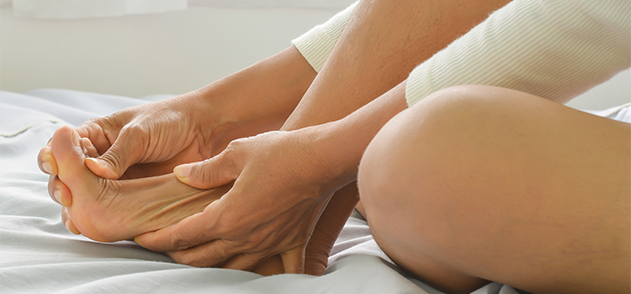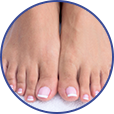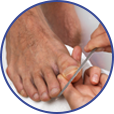HOME > ABOUT NAIL FUNGUS > PREVENTION OF NAIL FUNGUS
Nail Fungus Prevention

Nail fungus, or onychomycosis, is one of the world’s most common dermatological disorders, with an estimated worldwide prevalence of 3-26%. It’s more common in adults, particularly in people over 60 and those with immunosuppressive conditions. In this guide, you’ll learn why nail fungus comes back and how to keep it from happening.
Why Nail Fungus Comes back
Even after a successful treatment, there’s a chance that nail fungus will come back. That’s why it’s best to continue using topical and oral treatments for months after the infection has been eliminated. However, some people are simply more susceptible to recurring fungal infections. Fungus, particularly that on the fingernails and toenails, often recurs because the skin doesn’t recognize it as foreign. When the fungus has been in the skin for a long time, the immune system becomes accustomed to it and doesn’t try to fight it anymore. Fungal infections may return via contact with spores, or reproductive cells that grow into new fungi. These spores are often found in moist areas, or even in your footwear. In the following sections, you’ll get some tips on preventing the return of nail fungus.
Be Hygienic
Nail fungus prevention begins with you. Bacteria, fungi, and other skin-dwelling organisms won’t take hold if you practice proper hygiene. Similarly, even if you use the most effective treatment available, the infection won’t go away if your hygiene habits are questionable. Follow these simple tips for clean, fungus-free nails and skin. Wash your entire body, including your fingernails and toenails, regularly and thoroughly with soap and warm water. Don’t forget about the areas between your fingers and toes, as fungi often live in these areas. Dry your body completely before putting on socks, clothing, and footwear.
Keep your nails trimmed to a manageable length. However, you should avoid cutting them too closely, as even the smallest laceration will allow fungi and bacteria in.
Choose Clean and Proper Footwear
Moist feet in tight-fitting shoes are more likely to acquire fungi. Choose breathable shoes, and wear moisture-wicking socks. Change your socks as often as necessary, and avoid wearing dirty, old, and sweaty shoes whenever possible. If you’re using a public shower or pool, don’t walk barefoot; wear sandals or flip-flops. Above all, don’t share your shoes with others.
Know Cleanliness of Your Surroundings
Choose health clubs, nail salons, spas, and other places based on their cleanliness and other factors. Places like these are frequented by hundreds of people each day, some of whom may have a fungal infection. Be sure the establishments you choose sanitize equipment on a regular basis. If you choose, you can bring your own nail care implements to the salon, so you’re sure they’re sterile.
Treat Fungal Infections Immediately
Many nail fungus infections arise from athlete’s foot or other body fungi. It’s important to treat athlete’s foot as soon as possible to prevent fungi from spreading to your nails. Consult our treatment guide for some easy-to-follow tips on eliminating fungal infections at the source.
Use Antifungal Treatments
Antifungal topical and oral treatments not only address an existing nail fungal infection, but they prevent reoccurrences. Effective topical solutions, such as those with 10% undecylenic acid and penetrating agents, can kill fungi under the nail where they live. Apply these treatments on affected nails and surrounding skin on a regular basis, or as recommended by the product’s manufacturer.
Nail Fungus: How Caontagious is it?
As mentioned earlier in this guide, nail fungus is extremely contagious, spreading from person to person or through contaminated clothing and footwear. Avoid sharing socks and shoes with someone who’s had a fungal infection. Many don’t realize they have nail fungus, and if you wear something of theirs, you put yourself at risk of infection. Things such as towels, nail polish, and nail care implements shouldn’t be shared, either. If you share a home with someone who has nail fungus, wear sandals or shoes in areas where they may have walked barefoot, such as the shower and bathroom. Nail fungus can be contagious even if it looks like it’s clearing up. If you’re dealing with a fungal infection under your nails, don’t share items and don’t allow anyone to touch the affected area until the fungus has been eliminated.
In Conclusion
It’s quite time-consuming to treat a nail fungus infection, and even with a successful treatment, there’s always the chance of a reoccurrence. While some people are more vulnerable to recurring nail fungus infections, others repeatedly pick them up from their surroundings. It’s possible to eliminate existing fungus but keeping it from coming back is a bit more difficult. By being careful about your environment, practicing proper hygiene, and using OTC products for treatment and prevention, you’re more likely to successfully defend against nail fungus.
Know your nail fungus

What is it? How did you get it? How does it look? What color is it? Once you know these things, what should you do?
Get rid of nail fungus

No, nail fungus won't haunt you forever. Learn how to finally kill it with our guidance.
What to buy

We'll review various over-the-counter nail fungus treatments, highlighting what we liked and didn't like about each.

Your Source for Clear,
Healthy Nails. Expert Reviews,
Tips & Solutions. Empowering
You to Eliminate Nail Fungus
for Good!
